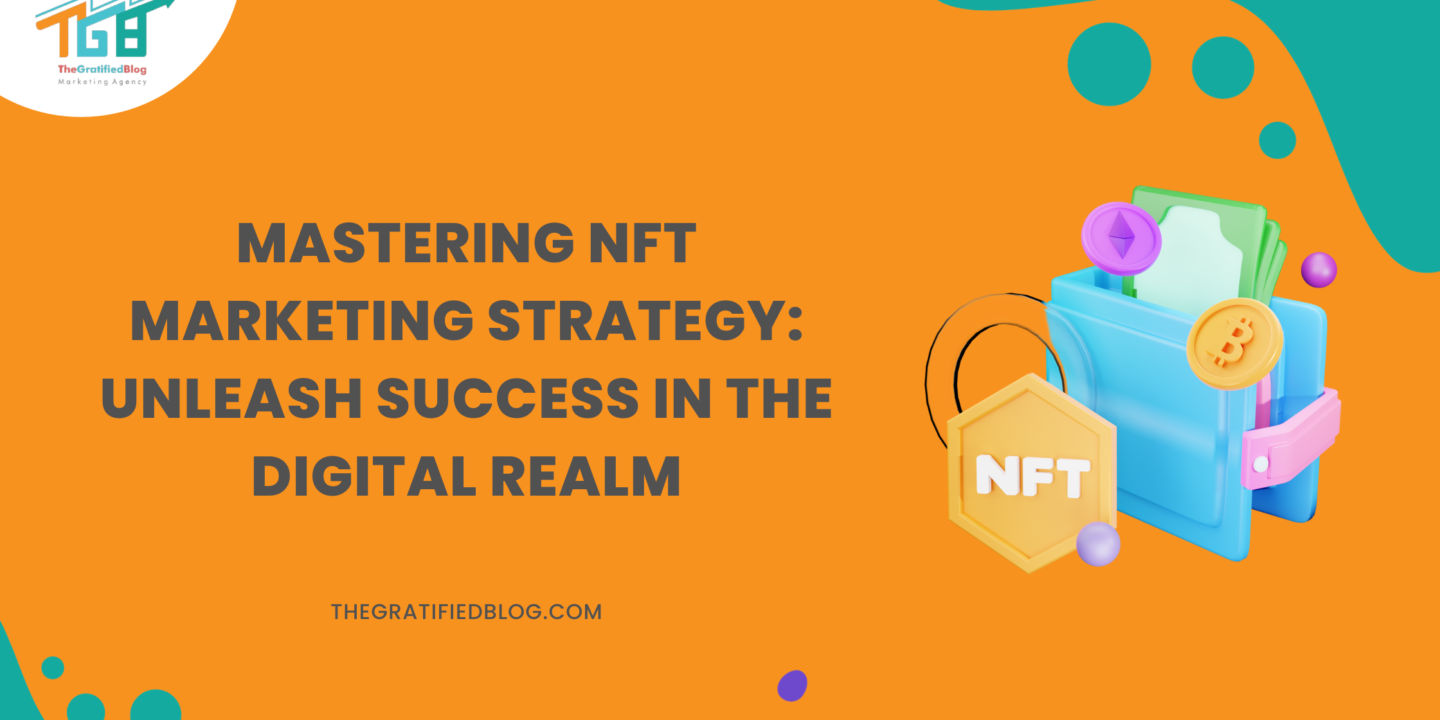
In the ever-evolving landscape of the digital age, Non-Fungible Tokens (NFTs) have emerged as a groundbreaking phenomenon reshaping how we perceive and engage with art, collectibles, and digital assets. As NFTs continue to gain momentum, their allure extends far beyond the realm of blockchain enthusiasts, attracting artists, creators, investors, and brands alike. However, creating and listing an NFT is no longer sufficient in this dynamic and competitive ecosystem. A well-crafted and meticulously executed NFT marketing strategy is essential to succeed in the NFT space.
This blog will embark on a comprehensive journey through NFTs, diving deep into various aspects. Let’s start by delving into the basic principles of NFTs and then examine their operational mechanisms. We’ll examine the elements contributing to their remarkable rise in popularity.
Additionally, we will scrutinize the challenges encountered in NFT marketing and elucidate the strategies employed to navigate these challenges successfully. Furthermore, we will gaze towards the future, exploring upcoming trends in NFT marketing. Ultimately, our journey will culminate in a well-rounded and insightful conclusion.
So, fasten your seatbelts as we embark on a journey through the exciting world of NFTs and discover the critical elements of a winning NFT marketing strategy that can help you stand out in this ever-expanding digital frontier.
So, let’s get started:
What Are NFTs?
NFTs are unique digital assets representing possession or verification of the genuineness of a specific item’s content, typically stored on a blockchain.
Cryptocurrencies like Bitcoin or Ethereum, NFTs are non-fungible, indicating that each token is distinct and cannot be exchanged on a one-to-one basis with another NFT.
Imagine owning a rare piece of art, a collectible trading card, a virtual real estate plot in a metaverse, or even a tweet from a celebrity – all of these can be transformed into NFTs. NFTs provide a way to verify the scarcity and uniqueness of digital or physical assets in the digital realm.
How Do NFTs Work?
The inner workings of NFTs revolve around blockchain technology, specifically Ethereum, which is the most common blockchain used for NFT creation.
Here’s a simplified breakdown of how NFTs function:
Creation
A creator mints an NFT by encoding ownership information and metadata onto a blockchain. Metadata can include details about the asset, such as its title, creator, description, and associated files, such as images, videos, or music.
Smart Contracts
Self-executing agreements with predefined rules govern NFTs. These smart contracts outline the ownership and transfer conditions of the NFT.
Ownership Transfer
When someone purchases an NFT, the intelligent contract updates the ownership record on the blockchain, transferring it to the buyer. This transaction is publicly recorded and can be verified by anyone.
Interoperability
NFTs are often designed to be interoperable across various platforms, meaning you can use the same NFT in different virtual worlds, games, or applications.
Immutable And Indivisible
NFTs are immutable, meaning their ownership history is permanent and cannot be altered. Additionally, they are indivisible, so you cannot split an NFT into smaller parts.
Now that we’ve established a foundational understanding of NFTs, including what they are and how they operate, let’s delve into the factors that have propelled their popularity. Additionally, we’ll explore the challenges that the NFT ecosystem currently confronts.
Factors Driving NFT Popularity And Challenges In NFT Marketing
Why NFTs Have Become Popular?

The popularity of NFTs can be attributed to several key factors:
- Digital Ownership: NFTs offer a groundbreaking shift by granting tangible ownership of digital assets. This introduces a sense of rarity and exclusivity to the digital sphere, where previously, the request was intangible. It allows individuals to truly possess and trade their digital creations or collectibles, instilling a novel level of authenticity.
- Creator Empowerment: NFTs empower artists, musicians, and creators to monetize their work directly; this groundbreaking feature eliminates the necessity for intermediaries, such as galleries or music labels, giving creators more control over their intellectual property and earnings and creating a more equitable digital economy.
- Collectibility: The allure of collecting rare and unique items is deeply ingrained in human nature. NFTs leverage this intrinsic desire, offering digital assets with inherent scarcity. Collectors are drawn to NFTs for their potential appreciation in value and the satisfaction of amassing a unique and exclusive digital collection.
- Blockchain Technology: The foundation of NFTs lies in blockchain technology, which ensures transparency, security, and authenticity in the digital realm. This addresses longstanding trust and credibility issues, as every NFT transaction and ownership record is irrevocably recorded on the blockchain, eliminating fraud and counterfeiting concerns.
- Hype and FOMO: High-profile NFT sales, celebrity endorsements, and social media buzz have generated remarkable excitement in the NFT space. That has cultivated a pervasive fear of missing out (FOMO) among investors and collectors, driving an unprecedented surge in demand for NFTs.
- Digital Experiences: NFTs extend beyond mere ownership by offering exclusive digital experiences. These can range from immersive virtual reality worlds to augmented reality art installations and in-game assets. These unique experiences augment the value of NFTs, making them more than just static digital assets and instead gateways to dynamic digital worlds.
Challenges In NFT Marketing

NFT marketing has its challenges. Here are some common hurdles that marketers in this space face:
- Noise and Saturation: The sheer volume of NFT projects and promotional content flooding the market can overwhelm potential buyers and make it challenging for any project to stand out. Cutting through this noise to capture attention becomes daunting for NFT marketers, requiring innovative and effective strategies.
- Scams and Fraud: The NFT ecosystem has witnessed many scams and fraudulent activities, ranging from counterfeit NFTs to phishing schemes. These incidents have made consumers cautious and skeptical, impacting trust within the community and making it imperative for marketers to establish trustworthiness and transparency.
- Legal and Regulatory Uncertainty: The evolving legal and regulatory landscape surrounding NFTs creates uncertainty for marketers and participants. Questions about intellectual property rights, taxation, and securities regulations remain unresolved. Navigating this uncertainty demands vigilance and a commitment to compliance with emerging laws.
- Community Expectations: Building and nurturing a passionate community around an NFT project can be rewarding, but it also comes with high expectations. Community members often anticipate active engagement, transparency, and meaningful interactions. Meeting these expectations and maintaining community satisfaction can significantly challenge NFT marketers.
- Market Volatility: The NFT market exhibits high price volatility in pricing and demand for NFTs. Fluctuations in the value of NFTs can affect marketing strategies, requiring marketers to adapt to changing market conditions and the sentiment of investors, which can be a complex and unpredictable task.
Having explored the reasons behind their rising popularity and the challenges they encounter, we can now shift our focus towards comprehending the intricacies of NFT marketing strategy.
NFT Marketing Strategy
Target Audience Identification
Identifying your target audience is fundamental in crafting a successful NFT marketing strategy. NFTs cater to diverse niches, and understanding who your ideal buyers and collectors are can help tailor your efforts.
Here’s how to go about it:
- Market Research: Undertake comprehensive research to comprehend the demographics, interests, and behaviors of potential NFT enthusiasts within your niche.
- Buyer Personas: Develop buyer personas that embody your ideal customers. Consider factors like age, gender, location, income, and interests.
- Segmentation: Split your audience into segments according to shared characteristics. That allows for more precise targeting and messaging.
- Behavior Analysis: Analyze how your target audience interacts with NFTs, what motivates them to purchase, and where they spend their time online.
Branding And Positioning

Your NFT project’s branding and positioning set the stage for how it’s perceived in the market. This is where you establish your project’s identity and differentiate it from others.
Key considerations include:
- Brand Identity: Develop a solid and unique brand identity that reflects the essence of your NFT project. That includes a memorable logo, color scheme, and visual style.
- Value Proposition: Clearly define what makes your NFTs unique. Is it the artistry, the utility, or the creator’s reputation? Highlight these unique selling points.
- Consistency: Ensure consistency in branding across all channels, from your website to your social media profiles.
- Storytelling: Employ narrative techniques to establish an emotional connection with your audience. Share the story behind your NFT project and the inspiration behind each piece.
Content Creation And Storytelling

Content is the lifeblood of your NFT marketing strategy. It’s how you engage and educate your audience.
Here’s how to approach content creation:
- High-Quality Assets: Ensure that the NFTs you create are of the highest quality. The more exceptional the art or utility, the more appealing it becomes.
- Educational Content: Generate content that enlightens your audience on NFTs, the blockchain, and the value of digital ownership. That can include blog posts, videos, webinars, and infographics.
- Behind-the-Scenes: Provide a peek into the process of your creative endeavors and the making of your NFTs. That can build anticipation and intrigue.
- Engage in Storytelling: Tell stories about the inspiration, challenges, and journeys behind your NFTs. People love to connect with the human aspect of creations.
Social Media Engagement
It is a powerful tool for promoting NFTs and engaging with your audience.
Here’s how to make the most of it:
- Platform Selection: Opt for the social media channels that align with your target audience. Platforms like Twitter, Instagram, and Discord are for NFTsr choices.
- Consistent Posting: Sustain a consistent schedule for posting to ensure ongoing engagement with your audience; share updates, previews, and behind-the-scenes content.
- Engage with Followers: Respond to comments, messages, and mentions promptly. Cultivating a connection with your audience nurtures trust and loyalty.
- Hashtags: Employ pertinent hashtags to broaden the reach of your content. Posts—research trending NFT hashtags to tap into ongoing conversations.
Influencer Partnerships
Collaborating with influencers can amplify your NFT marketing efforts by tapping into their established audiences.
Here’s how to approach influencer partnerships:
- Identify Relevant Influencers: Seek out influencers within your niche who genuinely are interested in NFTs and align with your brand values.
- Engage in Outreach: Reach out to influencers with a compelling pitch, emphasizing the mutual benefits of the partnership.
- Co-Creation: Collaborate with influencers on unique NFT releases, giveaways, or promotions. Their endorsement can drive considerable interest.
- Authenticity: Ensure the influencers you partner with genuinely believe in your project. Realism is critical to maintaining credibility.
Community Building
Establishing a robust and engaged community centered around your NFT project is vital for long-term success. Here’s how to foster community:
- Establish a Discord or Telegram Channel: Create a dedicated space for your community to discuss, ask questions, and connect.
- Regular Updates: Ensure your community stays informed about project developments, upcoming releases, and events.
- Engagement Activities: Host events, giveaways, and contests to encourage participation and interaction within the community.
- Feedback and Input: Listen to your community’s feedback and suggestions. Involving them in decision-making can enhance their sense of ownership.
Incorporating these elements into your NFT marketing strategy will help you navigate the competitive NFT landscape and build a strong foundation for success. Each aspect complements the others, contributing to a comprehensive and practical marketing approach.
Future Trends In NFT Marketing
The world of NFTs is dynamic and ever-evolving, and to stay ahead in the NFT marketing game, it’s crucial to keep an eye on emerging trends. Here are some future trends that are expected to shape NFT marketing strategies:
Metaverse Integration
As the metaverse concept gains traction, NFT marketing will likely become increasingly intertwined with virtual worlds and immersive digital environments. NFTs will serve as digital assets within the metal and as marketing tools to promote and establish brands or creators in these spaces.
Marketers may explore opportunities for virtual events, exhibitions, and unique experiences within metaverse environments to engage with audiences on a deeper level. NFTs could represent entry tickets, access to exclusive metaverse content, or virtual real estate within these digital realms. Seamless integration of NFT marketing into the metaverse will be a strategic move for brands and creators alike.
Blockchain Technology Advancements
Blockchain technology, the backbone of NFTs, continues to evolve, and these advancements will profoundly impact NFT marketing. Enhanced scalability and reduced energy consumption are just a few of the improvements. This will lower transaction fees, making NFTs more accessible to a broader audience.
Furthermore, advanced blockchain features like Layer 2 solutions and interoperability between different blockchain networks may open new marketing possibilities. To remain updated on these developments, marketers must stay informed, adapt their strategies, and effectively leverage the latest blockchain technologies.
Regulation And Compliance
One of the pressing challenges in the NFT space is the need for regulatory clarity. Governments and regulatory bodies increasingly focus on NFTs, which could lead to more stringent rules and compliance requirements. NFT marketers must be prepared to navigate this evolving regulatory landscape.
Compliance with intellectual property rights, tax regulations, and securities laws will be paramount. Projects that prioritize transparency, security, and adherence to emerging principles will gain the trust of both creators and collectors. In the future, we can anticipate more robust Legal frameworks designed to protect the rights and interests of all involved parties in the NFT ecosystem.
Conclusion
Now that you’ve comprehensively grasped NFT marketing strategy, there’s no need to replicate someone else’s approach. Instead, consider implementing the abovementioned strategies to witness the transformative potential they can bring to your NFT endeavors.If you still have questions about this blog, please leave them in the comments section. We will be happy to answer your question.
Thanks for reading 🙂
Also read: A Complete Guide To know Are NFTs Dead?








No Comments